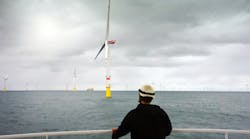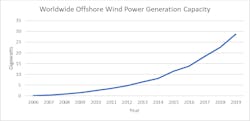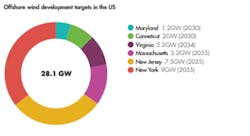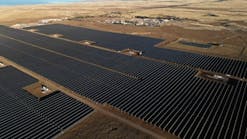The White House recently announced that the Departments of Interior, Energy, and Commerce had formed a shared goal to facilitate the deployment of 30 GW of offshore wind by 2030.
This goal builds on President Biden’s Executive Order to the Secretary of the Interior to identify steps to take within existing laws to increase renewable energy production. If achieved, this would be a massive increase in US offshore wind capacity. Right now, the US has 30 MW off the coast of Rhode Island and 12 MW off the coast of Virginia for a total of just 0.042 GW.
For context, the Global Offshore Wind Council reported that the entire worldwide offshore wind capacity stood at about 29 GW at the end of 2019. As shown in the graphic below, the worldwide offshore wind capacity was essentially built over the last 15 years.
Timeframe
The US goal is to build its 30 GW in about half the time.
How realistic is this? While the US has just 0.14% of this goal already installed, significant plans have been launched and projects are under development. Individual states already have targets totaling 28 GW by 2035. State plans include:
Permitting
To make these plans a reality a full five years before some of the target dates, faster federal permitting is essential. The Bureau of Ocean Energy Management’s extensive and detailed processes can take five or more years. As a result, achieving a 30-GW goal by 2030 will require much faster process times. The administration’s stated commitment to speed up is a welcome and an enabling development. For example: "The Biden administration's recent announcement to prioritize and expand offshore wind projects is exciting news and a step in the right direction in halting climate change and creating hundreds of well-paying clean energy jobs,” said Kenneth Bowes, vice president, Offshore Wind Siting & Permitting. "At Eversource Energy, we are committed and focused on creating a clean energy future and look forward to helping advance the bold clean energy goals being set by the Biden administration."
Expertise
Another challenge will be to ramp up and develop the necessary engineering expertise, port facilities and supply chain capacity. Here, the US has the benefit of existing European expertise and specialized equipment. For example, US utility Eversource Energy is partnering with Danish Wind Power firm Ørsted A/V (formerly known as DONG Energy) for the 2-GW Bay State Wind Project. Ørsted is also part of the two US operational offshore wind projects. As a result, faster project execution times are possible.
Adding 30 GW of offshore wind will bring operational challenges as well. Since wind is an intermittent power source, it will need to be balanced by other generation with rapid power ramp rate capabilities. Here in New England, the 1-GW Northfield Mountain pumped-storage hydro unit is an excellent resource. Yet, even this large-capacity unit might need to be supplemented to be able to balance the targeted 5+ GW of offshore wind within the ISO-New England part of the US Eastern Interconnection Transmission Grid.
Conclusion
So where does all of this leave us? Looking at these facts, the US administration’s goal of 30 GW by 2030 seems like a significant stretch. Even so, the US will surely join Europe and Asia in using offshore wind for a more renewable, sustainable future.
References:
- “FACT SHEET: Biden Administration Jumpstarts Offshore Wind Energy Projects to Create Jobs “, The White House, March 29, 2021, Available Online at: https://www.whitehouse.gov/briefing-room/statements-releases/2021/03/29/fact-sheet-biden-administration-jumpstarts-offshore-wind-energy-projects-to-create-jobs/
- Executive Order 14008 of January 27, 2021, “Tackling the Climate Crisis at Home and Abroad”, Available Online at: https://www.federalregister.gov/documents/2021/02/01/2021-02177/tackling-the-climate-crisis-at-home-and-abroad
- “Wind explained Where wind power is harnessed”, U.S. Energy information Agency, Available Online at: https://www.eia.gov/energyexplained/wind/where-wind-power-is-harnessed.php
- “GLOBAL OFFSHORE WIND REPORT 2020”, Lead Authors: Joyce Lee, Feng Zhao, Contributing Authors: Alastair Dutton, Ben Backwell, Liming Qiao, Shuxin Lim, Anjali Lathigaralead, Wanliang Liang, Global Wind Energy Council, 5 August, 2020, Available online at: https://gwec.net/wp-content/uploads/2020/12/GWEC-Global-Offshore-Wind-Report-2020.pdf
- “DONG Energy Wind Power U.S. Inc. and Eversource Announce Partnership to Make Large-Scale Offshore Wind a Reality in the United States “, Ørsted A/S, December 14, 2016, Available online at: https://orsted.com/en/media/newsroom/news/2016/12/dong-energy-wind-power-us-inc-and-eversource-announce-partnership and https://us.orsted.com/wind-projects
- “Coastal Virginia Offshore Wind”, Dominion Energy, Copyright 2021, Available online at: https://coastalvawind.com/about-offshore-wind/delivering-wind-power.aspx#sec3
- “New England's Largest Battery Is Hidden Inside A Mass. Mountain”, Bruce Gellerman, WBUR, December 2, 2016, Available online at: https://www.wbur.org/bostonomix/2016/12/02/northfield-mountain-hydroelectric-station




